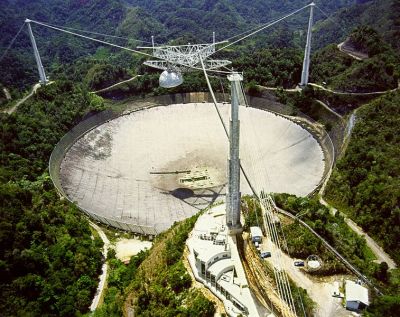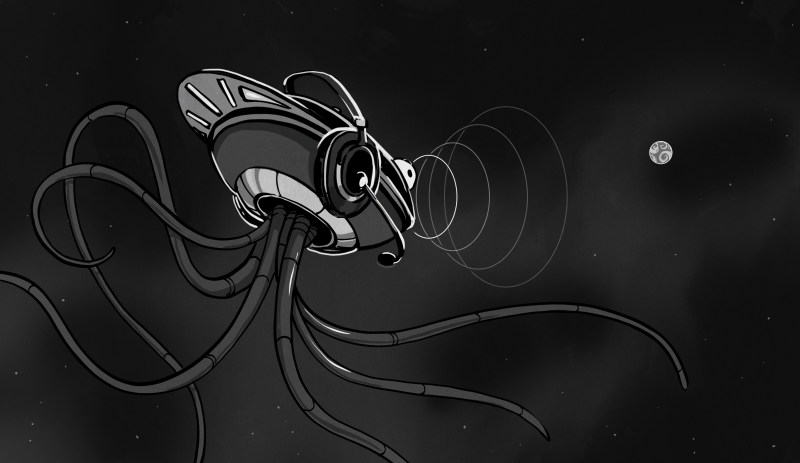Every 26 months, Earth and Mars come tantalizingly close by virtue of their relative orbits. The closest they’ve been in recent memory was a mere 55.7 million kilometers, a proximity not seen in 60,000 years when it happened in 2003.
However, we’ve been playing close attention to Mars for longer than that. All the way back in 1924, astronomers and scientists were contemplating another close fly by from the red planet. With radio then being the hot new technology on the block, the question was raised—should we be listening for transmissions from fellows over on Mars?
I Got Too Excited When I Thought You Were Around

Flashback to 1924, a time when the cosmos was less understood but no less marveled at. Earth and Mars were drawing near, and with that, an ambitious, albeit quaint by today’s standards, attempt to probe the Red Planet for signs of life was set into motion. It wasn’t with the sophisticated rovers or orbiters of the modern era. Instead, the plan was to keep out a listening ear for potential Martian radio broadcasts.
The backdrop to this interplanetary eavesdropping was a world captivated by the possibilities that have all but been dashed today. It’s funny to think, but 100 years ago, astronomers and scientists knew much less about the solar system. The idea that Mars was not just another speck in the sky but a world teeming with life, perhaps even civilizations, was still a somewhat viable one.
By 1924, theories of canals on Mars and potential intelligent life were on the books. They weren’t necessarily widely believed, but they were a topic of scientific discussion in recent decades that hadn’t outright been disproved. Increasing knowledge of the planets was beginning to suggest to scientists that our neighbouring rocks might be uninhabitable, but the matter wasn’t by any means settled.
Despite the growing skepticism within the scientific community, the hope of contacting Martian life lingered. So, in 1924, as Earth and Mars drew close like cosmic neighbors leaning over a fence, the U.S. orchestrated a grand gesture, just on a chance—National Radio Silence Day.
The idea was that terrestrial radio transmissions should be hushed as much as possible such that any Martian transmissions might better be heard by radio operators. Citizens were urged to quiet their radio transmissions for the first five minutes of every hour. US naval stations were instructed to lend Earth’s ears to the cosmos, noting and reporting “any electrical phenomenon” of unusual character across “as wide band frequencies as possible.” This was all in the hope that someone, somewhere might hear a faint howdy or hello from a Martian. It was a moment of wide-eyed optimism. The hope was to hear a crackle from a speaker. Some distant sound that told us somebody else was out there.

The day was actually promoted as a 36-hour long period from August 21 to August 23. The United States Naval Observatory went as far as using a small airship to raise a radio receiver 3 km (1.8 miles) into the air for better reception. A Professor David Peck Todd had been charged with clearing the airwaves, and persuaded the Army and Navy to log observations over the three-day period. He was allegedly less successful in convincing private broadcasters, who were reluctant to wind back operations for so long.
Alas, with ears turned to the sky, the cosmos remained silent. Either the people of Mars were too busy to contact us, or they didn’t want to make new friends. Or, as we assume today, there were simply no Martians to begin with. No Martian dispatches were received, and Earth was left to ponder the silence.
It’s easy to look back and think about what a long shot it really was. A bunch of low-tech receivers hoping to pick something up on relatively low-frequency bands, listening out for a transmission from a planet drier than an Appalachian summer. But that’s all with the benefit of hindsight. If you were back in 1924, and knew what they knew back then, could you have resisted firing up your receiver for a listen?
The Modern Age
Today, we understand much more about the harsh realities of Mars, its barren landscapes, and thin atmosphere offering scant hospitality for life as we know it. We’re pretty certain nobody’s kicking around over there, and we’re not listening out for their Top 40 stations or diplomatic calls to establish relations with Earth.

And yet the search for extraterrestrial intelligence goes on. It’s so much more sophisticated now, with scientists hunting for emissions in different frequencies and aiming radio telescopes into patches of sky we think most likely might harbor some new friends. By the 1990s, systems like the Billion-channel Extraterrestrial Array (BETA) were monitoring hundreds of millions of radio channels at once with multiple antennas automatically investigating any candidate signals captured for further investigation. After the letdown of the Wow! Signal, scientists adapted new techniques to better capture potential signals from space and rule out those that came from Earth. We’ve even made our own transmissions in an attempt to reach out directly to other species.
As of yet, we’re yet to find definitive evidence that anyone else is in this big old universe with us. Some find that a comfort, while others find it lonely. At its heart, humanity is a social species. One that has always dreamed and wondered about who might be living on the other side of those mountains on the horizon. We’ve had that answer to that question for a long time now. As for who lies beyond the neighbourhood of our star system? We’ll be watching and wondering for some time yet.















I wonder what it was like to live in an era where we were on the verge of space exploration and still believed Venus was a jungle planet. So much promise, such adventure.
From 1954: “All Summer in a Day” is a short story written by Ray Bradbury, where the characters live on the sunless planet Venus, where it rains all day, every day. The sun only comes around every seven years, and Margot, the main character seems to be the only one who vividly remembers the sun.
Also from Ray Bradbury from 1950: “The Long Rain” – The story is set on Venus in a jungle, where a group of four men whose rocket has crashed are attempting to reach the safety of a Sun Dome. Bradbury portrays Venus as having nearly eternal rains. The men depend on the Sun Domes, lit and warmed by a miniature sun and filled with provisions, to keep from going insane.
When I was a kid (early 60’s) I had a map of the planets on the wall – most of the descriptions were labeled ‘unknown’ and the pictures of some of them were the products of artists imagination as there were no pictures of them with any resolution yet. I remember also a drawing in a book of mine of a future astronaut walking around on mars with only an oxygen mask – no space suit required on a nice day – as it was thought at the time that the air-pressure (even though mostly CO2) would be high enough to only require a source of oxygen . This and other conceptions of the planets all changed as the space probes began to send pictures of what they actually looked like – . and how unfriendly they were to our form of life – culminating with the pass by pluto a few years ago.
And of course the ‘cold war’ was happening and there was this mess in indo-china……
Now we have to repair the bulging hull of our out of control spaceship knowing about all the desolate worlds around us. More than half a century of this knowledge and more than double the population.
Also look up the movie ‘Queen of Outer Space’, set on Venus. In it, Venus isan all female planet and the leader woman has most men killed, keeping only male mathematicians and scientists on a prison colony moon orbiting Venus.
“All Summer in a Day”.
An exceptionally cruel story of what happened to Margot.
Fifty years later, it still haunts me.
Yup, too many people don’t understand that we inhabit the ONLY planet in our star system where one won’t quickly expire on its surface without serious protection. All the more reason to protect!! The next nearest systems are the alpha/proxima centauri star systems that are approximately 4 light years out, a hopeless distance given our current technology.
Arecibo isn’t simply “defunct”, as the caption states.
It collapsed a few years ago, and the political bean-counters refuse to pay to rebuild it.
I read the detailed report on the cause of the 1 Dec 2020 collapse which were defective cable swages fairly recently installed with an upgrade which increased the weight required to be supported.
Strangely, nowhere in the HIGHLY detailed report did it identify WHERE the giant, lead-filled swages were manufactured, so I emailed all of those authorities involved in the report to ask. No one answered.
BTW, have you seen:
Five-hundred-meter Aperture Spherical (Radio) Telescope
https://en.wikipedia.org/wiki/Five-hundred-meter_Aperture_Spherical_Telescope
The Five-hundred-meter Aperture Spherical Telescope is a radio telescope located in the Dawodang depression, a natural basin in Pingtang County, Guizhou, southwest China. FAST has a 500 m (1,600 ft) diameter dish constructed in a natural depression in the landscape. It is the world’s largest filled-aperture radio telescope and the second-largest single-dish aperture, after the sparsely-filled RATAN-600 in Russia
Construction of FAST began in 2011. It observed first light in September 2016. After three years of testing and commissioning, it was declared fully operational on 11 January 2020.
Every nickle spent on science earns $100 in benefit to all society. Look at the device in your hand.
“Fire bad. Spear Bad. No waste time. Go dig roots.”
Attitudes like this have been around a long time, and sadly they aren’t going anywhere soon.
In a sense, the search began much earlier: with ancient civilizations observing the tracks of planets on the sky, and searching for meaning in them.
To be fair, Tesla claimed that he had received transmissions from Mars. Yes, it’s tainted by the insanity thing, but a report is a report. We still have that place in West Virginia amirite?
That wacky Elon!
Yeah just like that whacky Einstein!
Yeah my first thought was about Tesla, too. Surprised he didn’t get a mention.
I’ll say it — why? The problem has never been with food availability or production, but with delivery logistics, theft, and greed. Tax money will never fix the latter three.
Why do you want to starve children?
I subscribe, as I’ve attested to many times before, the Bill Watterson Theory on the matter.
“The surest proof of intelligent life elsewhere in the universe is that we HAVEN’T been contacted.”
Statistically it is virtually certain that life forms exist elsewhere in the universe, but my theory is that we will never have contact with them because given the vast distances involved, life forms inherently develop the means to destroy themselves long before they develop the technology for space travel or even detectable space communication.
We kinda have space travel and the technology to beam messages. Question is where and how. Other question: Do we really want to announce our presence? Project bluebook said we were incapable of defending ourselves against a slightly superior society that could arrive.
♫ ♫ ♫
“Ezekiel saw the wheels;
Way in the middle of the air.”
♫ ♫ ♫
Yeah, it was a UFO, right? Wrong, it was a parhelic circle. Here is an example of not just four, but five full or partial “wheels” https://1.bp.blogspot.com/-DnJFj0tWr2s/WLhJsL9sUbI/AAAAAAAAEKY/wPpkbTWjrTcOGfjiGwqSFd3Wbvw8HYv8ACLcB/s640/5970_%25D1%258525-art_ver.JPG . Oh, I know, they have been known of for thousands of years, so it could not be that. Wrong again, time to use some common sense. In the middle east they are a once in a lifetime event, at best. Anyone from that region would have observed it as a divine event, that in later times would have even lower educated people claim also it was a divine event, or worse, UFO/s.